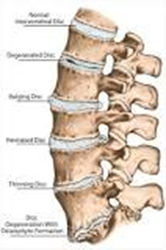A nurse is caring for a client who has degenerative disc disease. Which of the following assessment findings should the nurse understand might develop with this condition?
(Select All that Apply.)
Hyponatremia
Paresthesia
Foot drop
Intermittent pain Hyperreflexia
Correct Answer : B,C,D
Choice A Reason:
Hyponatremia is incorrect. Hyponatremia refers to low sodium levels in the blood and is not typically associated with degenerative disc disease. This finding is unrelated to the pathophysiology of DDD.
Choice B Reason:
Paresthesia is correct. Yes, paresthesia, which refers to abnormal sensations such as tingling, numbness, or burning, can develop with degenerative disc disease. Nerve compression or irritation due to disc degeneration can lead to paresthesia in the affected area, typically radiating along the nerve pathway.
Choice B Reason:
Foot drop is correct. Yes, foot drop can develop with degenerative disc disease, especially if the condition leads to nerve compression or damage in the lumbar spine (lower back). Foot drop refers to difficulty lifting the front part of the foot due to weakness or paralysis of the muscles involved in dorsiflexion.
Choice D Reason:
Intermittent pain is correct. Yes, intermittent pain is a hallmark symptom of degenerative disc disease. Pain may vary in intensity and may worsen with certain movements or activities. Individuals with DDD may experience episodes of acute pain, as well as chronic, persistent discomfort.

Nursing Test Bank
Naxlex Comprehensive Predictor Exams
Related Questions
Correct Answer is D
Explanation
Choice A Reason:
Dyspnea is not commonly seen in other chronic conditions of the aging older adult: This statement is incorrect. Dyspnea, or difficulty breathing, can occur in various chronic conditions commonly seen in aging adults, such as chronic obstructive pulmonary disease (COPD), heart failure, and pulmonary fibrosis, among others. Dyspnea can be a symptom of respiratory or cardiovascular issues and is not exclusive to asthma.
Choice B Reason:
Aging is associated with decreased sensitivity to medications: This statement is generally incorrect. Aging can affect drug metabolism and clearance, leading to changes in medication sensitivity. Older adults may have altered pharmacokinetics and pharmacodynamics, which can increase their sensitivity to certain medications, particularly those with sedative or CNS depressant effects. This increased sensitivity can potentially increase the risk of adverse drug reactions.
Choice C Reason:
Adverse reactions to medications in the aging older adult are lower: This statement is incorrect. While some physiological changes associated with aging may decrease the risk of adverse drug reactions, such as decreased renal function and altered drug metabolism, older adults are still at risk for adverse drug reactions due to factors such as polypharmacy, drug interactions, and increased sensitivity to medications.
Choice D Reason:
Physiological changes in the respiratory system can mimic the presence of airway obstruction: This statement is true. Physiological changes in the aging respiratory system, such as decreased lung elasticity, increased chest wall stiffness, and reduced respiratory muscle strength, can mimic the symptoms of airway obstruction seen in conditions like asthma or COPD. These changes can lead to decreased lung function, reduced exercise tolerance, and increased susceptibility to respiratory infections.
Correct Answer is ["A","B","C","D","E","F"]
Explanation
Choice A Reason:
Refraining from climbing ladders is appropriate. Climbing ladders involves a risk of falling, which can be particularly hazardous for individuals with epilepsy. Seizures can occur unexpectedly and may cause loss of muscle control or consciousness, increasing the risk of falls from heights such as ladders. Falling from a ladder during a seizure can result in serious injuries, including head trauma, fractures, or other injuries from impact. Advising the client to refrain from climbing ladders helps mitigate the risk of falls and associated injuries during a seizure episode, promoting their safety and well-being.
Choice B Reason:
Do not go swimming without a partner is inappropriate. Swimming alone can be dangerous for individuals with epilepsy as they may be at risk of drowning if they experience a seizure while in the water. Having a swimming partner can provide assistance and ensure safety in case of a seizure.
Choice C Reason:
Refraining from driving unless seizure-free for 3 months is appropriate. Driving restrictions are often recommended for individuals with epilepsy to minimize the risk of accidents caused by seizures. Many jurisdictions require individuals with epilepsy to be seizure-free for a certain period, typically around 3 to 6 months, before resuming driving.
Choice D Reason:
Avoiding using power tools is appropriate. Operating power tools or machinery can be hazardous if a seizure occurs, potentially leading to serious injuries. Therefore, individuals with epilepsy should avoid using power tools to reduce the risk of accidents during a seizure.
Choice E Reason:
Placing client on the floor when having a seizure is appropriate. Placing the client on the floor during a seizure helps prevent injury from falls. It is safer to have the individual lie down on a flat surface to reduce the risk of head injury or other trauma during the seizure.
Choice F Reason:
Placing client on their back when they are recovering from a seizure appropriate. Placing the client on their back after a seizure helps maintain an open airway and facilitates recovery. This position allows for proper breathing and circulation while monitoring the individual's condition.
Whether you are a student looking to ace your exams or a practicing nurse seeking to enhance your expertise , our nursing education contents will empower you with the confidence and competence to make a difference in the lives of patients and become a respected leader in the healthcare field.
Visit Naxlex, invest in your future and unlock endless possibilities with our unparalleled nursing education contents today
Report Wrong Answer on the Current Question
Do you disagree with the answer? If yes, what is your expected answer? Explain.
Kindly be descriptive with the issue you are facing.
